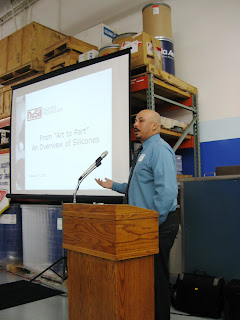From the ART of designing a part to the actual quality fabrication of the PART, Vincent Malave, Rick Ziebell, Torsten Kruse and Rick Finnie took 68 attendees through the process of how to get there. M.R. Mold & Engineering hosted a liquid silicone rubber workshop in conjunction with the Southern California chapter of SPE in their Tech Center in Brea, CA. The main focus of the workshop was a liquid silicone suction cup mold built by M.R. Mold & Engineering. The workshop encompassed how the silicone was chosen for this project using its physical properties, a flow analysis of the part design and the design of the mold itself. The workshop concluded by running the suction cup mold in M.R. Mold’s Tech Center.
Vincent Malave, a Southern West Coast Technical Salesperson for NuSil Technology, LLC. since 2001, spoke on how being fuel resistance, bio-compatibility, and able to remain elastomeric over a broad temperature range makes silicone an ideal material candidate for liquid injection molding applications.
Rick Ziebell, a graduate of chemical and materials engineering from California Polytechnic University with more than twenty-five years of experience in the rubber and plastic industry, gave participants a better understanding of the dynamic physical properties of silicone rubber. Rick taught the class how to take into account two crucial behaviors of silicone, “shear and heat thinning” and “cross-linking” in the injection molding process.
Torsten Kruse is a highly regarded industry expert in injection molding. He gave us incredible insight into how Sigma software can help us project the best way to accomplish mold filling and part curing, along with visualizing mold temperatures inside the mold over an entire cycle. Torsten explained how state-of-the-art simulation considers every technical detail of the injection molding process and its ability to solve problems before the mold is built.
Rick Finnie, president and owner of M.R. Mold & Engineering, explained how, after the product development is complete and a material has been selected, a mold must be built to produce the desired component. Care must be taken with the mold development to ensure the appropriate method of production is chosen. Critical factors include parting lines and gate location, as well as which process is the best application were discussed.
This event raised approximately $7500.00 for SPE's education fund.
Vincent Malave, a Southern West Coast Technical Salesperson for NuSil Technology, LLC. since 2001, spoke on how being fuel resistance, bio-compatibility, and able to remain elastomeric over a broad temperature range makes silicone an ideal material candidate for liquid injection molding applications.
Rick Ziebell, a graduate of chemical and materials engineering from California Polytechnic University with more than twenty-five years of experience in the rubber and plastic industry, gave participants a better understanding of the dynamic physical properties of silicone rubber. Rick taught the class how to take into account two crucial behaviors of silicone, “shear and heat thinning” and “cross-linking” in the injection molding process.
Torsten Kruse is a highly regarded industry expert in injection molding. He gave us incredible insight into how Sigma software can help us project the best way to accomplish mold filling and part curing, along with visualizing mold temperatures inside the mold over an entire cycle. Torsten explained how state-of-the-art simulation considers every technical detail of the injection molding process and its ability to solve problems before the mold is built.
Rick Finnie, president and owner of M.R. Mold & Engineering, explained how, after the product development is complete and a material has been selected, a mold must be built to produce the desired component. Care must be taken with the mold development to ensure the appropriate method of production is chosen. Critical factors include parting lines and gate location, as well as which process is the best application were discussed.
This event raised approximately $7500.00 for SPE's education fund.





Comments
Post a Comment